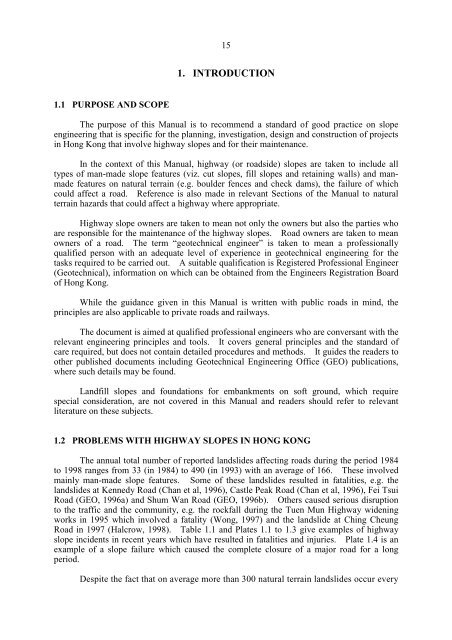Highway Slope Manual
Highway Slope Manual
Highway Slope Manual
You also want an ePaper? Increase the reach of your titles
YUMPU automatically turns print PDFs into web optimized ePapers that Google loves.
15<br />
1. INTRODUCTION<br />
1.1 PURPOSE AND SCOPE<br />
The purpose of this <strong>Manual</strong> is to recommend a standard of good practice on slope<br />
engineering that is specific for the planning, investigation, design and construction of projects<br />
in Hong Kong that involve highway slopes and for their maintenance.<br />
In the context of this <strong>Manual</strong>, highway (or roadside) slopes are taken to include all<br />
types of man-made slope features (viz. cut slopes, fill slopes and retaining walls) and manmade<br />
features on natural terrain (e.g. boulder fences and check dams), the failure of which<br />
could affect a road. Reference is also made in relevant Sections of the <strong>Manual</strong> to natural<br />
terrain hazards that could affect a highway where appropriate.<br />
<strong>Highway</strong> slope owners are taken to mean not only the owners but also the parties who<br />
are responsible for the maintenance of the highway slopes. Road owners are taken to mean<br />
owners of a road. The term “geotechnical engineer” is taken to mean a professionally<br />
qualified person with an adequate level of experience in geotechnical engineering for the<br />
tasks required to be carried out. A suitable qualification is Registered Professional Engineer<br />
(Geotechnical), information on which can be obtained from the Engineers Registration Board<br />
of Hong Kong.<br />
While the guidance given in this <strong>Manual</strong> is written with public roads in mind, the<br />
principles are also applicable to private roads and railways.<br />
The document is aimed at qualified professional engineers who are conversant with the<br />
relevant engineering principles and tools. It covers general principles and the standard of<br />
care required, but does not contain detailed procedures and methods. It guides the readers to<br />
other published documents including Geotechnical Engineering Office (GEO) publications,<br />
where such details may be found.<br />
Landfill slopes and foundations for embankments on soft ground, which require<br />
special consideration, are not covered in this <strong>Manual</strong> and readers should refer to relevant<br />
literature on these subjects.<br />
1.2 PROBLEMS WITH HIGHWAY SLOPES IN HONG KONG<br />
The annual total number of reported landslides affecting roads during the period 1984<br />
to 1998 ranges from 33 (in 1984) to 490 (in 1993) with an average of 166. These involved<br />
mainly man-made slope features. Some of these landslides resulted in fatalities, e.g. the<br />
landslides at Kennedy Road (Chan et al, 1996), Castle Peak Road (Chan et al, 1996), Fei Tsui<br />
Road (GEO, 1996a) and Shum Wan Road (GEO, 1996b). Others caused serious disruption<br />
to the traffic and the community, e.g. the rockfall during the Tuen Mun <strong>Highway</strong> widening<br />
works in 1995 which involved a fatality (Wong, 1997) and the landslide at Ching Cheung<br />
Road in 1997 (Halcrow, 1998). Table 1.1 and Plates 1.1 to 1.3 give examples of highway<br />
slope incidents in recent years which have resulted in fatalities and injuries. Plate 1.4 is an<br />
example of a slope failure which caused the complete closure of a major road for a long<br />
period.<br />
Despite the fact that on average more than 300 natural terrain landslides occur every

















